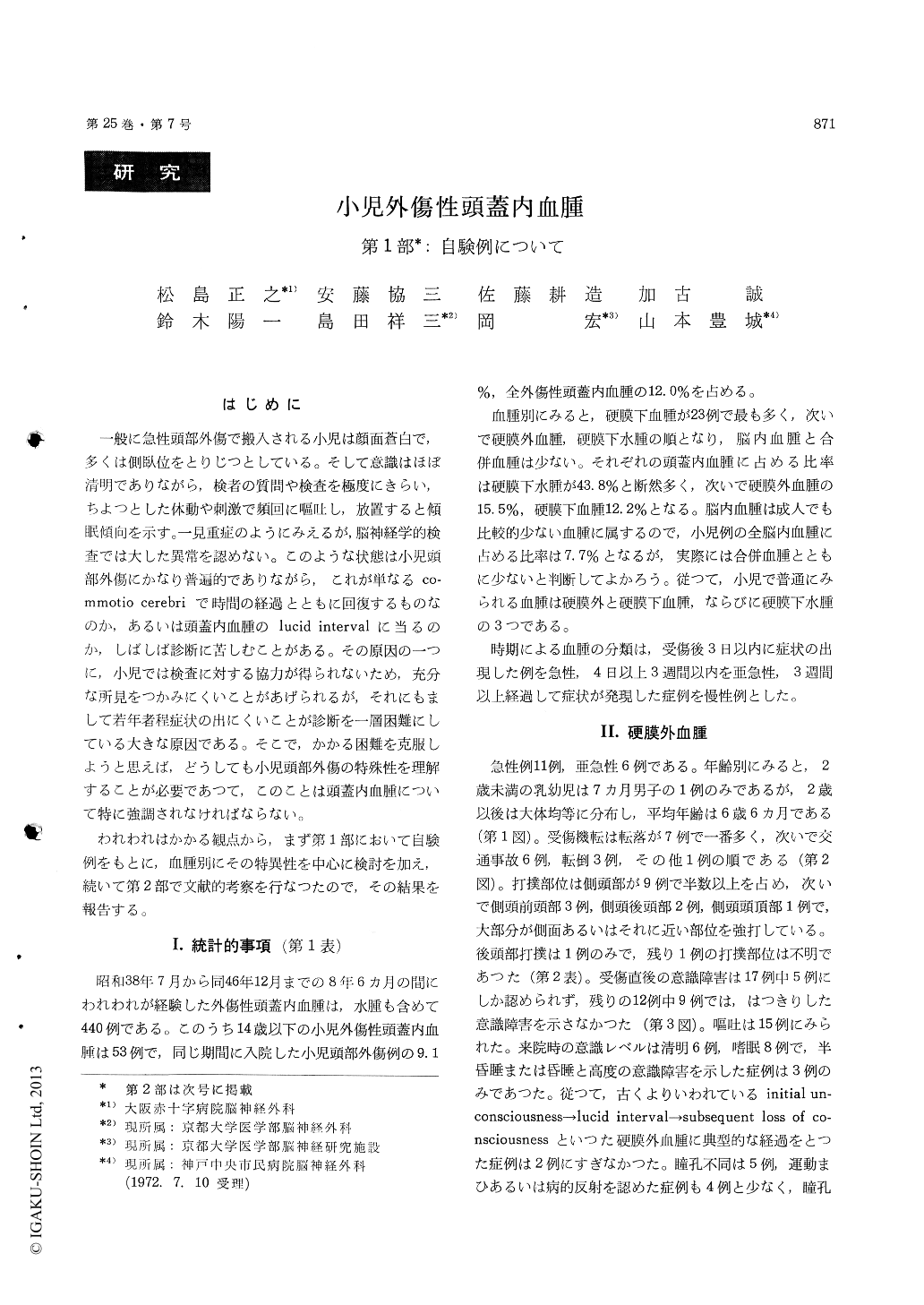Japanese
English
- 有料閲覧
- Abstract 文献概要
- 1ページ目 Look Inside
はじめに
一般に急性頭部外傷で搬入される小児は顔面蒼白で,多くは側臥位をとりじつとしている。そして意識はほぼ清明でありながら,検者の質問や検査を極度にきらい,ちよつとした体動や刺激で頻回に嘔吐し,放置すると傾眠傾向を示す。一見重症のようにみえるが,脳神経学的検査では大した異常を認めない。このような状態は小児頭部外傷にかなり普遍的でありながら,これが単なるco—mmotio cerebriで時間の経過とともに回復するものなのか,あるいは頭蓋内血腫のlucid intervalに当るのか,しばしば診断に苦しむことがある。その原因の一つに,小児では検査に対する協力が得られないため,充分な所見をつかみにくいことがあげられるが,それにもまして若年者程症状の出にくいことが診断を一層困難にしている大きな原因である。そこで,かかる困難を克服しようと思えば,どうしても小児頭部外傷の特殊性を理解することが必要であつて,このことは頭蓋内血腫について特に強調されなければならない。
われわれはかかる観点から,まず第1部において自験例をもとに,血腫別にその特異性を中心に検討を加え,続いて第2部で文献的考察を行なつたので,その結果を報告する。
Fifty three cases of traumatic intracranial he-matomas in children under 15 years of age were reported with a special reference to their charac-teristics in clinical pictures. They were admitted to Osaka Red Cross Hospital for last eight and ahalf years, and represented 12. 0 per cent of the total intracranial hematoma and 9. 1 per cent of all children hospitalized with head injury during this period.
The frequency of epidural hematoma in our series (17 cases) showed its common occurrence in children except for infancy. Skull fracture was noted in all cases in contrast to many reports of relatively frequent abscence of it. The lack of initial unconsciousness was very common in child-hood, and symptoms and signs were much more mild with the prolonged course than those of the adult. Even in such cases fairly large hematomas were evacuated at the operation. On the other hand, when the compensatory mechanism for in-creased intracranial pressure was broken down, the very rapid deterioration of the condition may ensue. These various courses of the hematoma must be recognized for their successful treatment.
Subdural hematomas (23 cases) were all derived from the postnatal head injury. In 11 of 16 acute cases they took place with an everyday head in-jury such as falling on a floor, and 10 of them were under 2 years of age. The common site of impact in these patients was the occiput, and no skull fracture was noted in them. In a case show-ing a typical course, the convulsion developed immediately after injury, followed by the rapid lowering of the level of consciousness. There was no association with the cerebral contusion ex-cept for two cases. In five of such patients it was recognized at the operation that the rupture of the bridging vein of the superior sagittal sinus was the source of bleeding. The mechanism in-volved in such occurrence of the hematoma would be explained by a shear strain produced between the brain and skull at the time of impact.
Other hematomas, intracerebral and combined, and the subdural hydroma were also described.

Copyright © 1973, Igaku-Shoin Ltd. All rights reserved.


